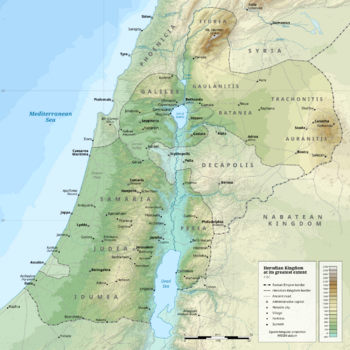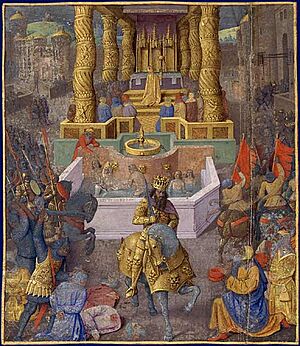Herodian kingdom facts for kids
Quick facts for kids
Herodian kingdom
|
|||||||||
|---|---|---|---|---|---|---|---|---|---|
| 37 BCE–4 BCE | |||||||||

Herodian Kingdom of Judea at its greatest extent
|
|||||||||
| Status | Client state of the Roman Republic / Roman Empire | ||||||||
| Capital | Jerusalem | ||||||||
| Common languages | Koine Greek, Aramaic, Latin, Hebrew | ||||||||
| Religion | Second Temple Judaism Samaritanism Roman imperial cult |
||||||||
| Government | Monarchy | ||||||||
| King | |||||||||
|
• 37 BCE – 4 BCE
|
Herod the Great | ||||||||
| Historical era | Augustan Age | ||||||||
|
• conquest of Hasmonean kingdom
|
37 BCE | ||||||||
|
• formation of Tetrarchy
|
4 BCE | ||||||||
| Currency | Herodian coinage | ||||||||
|
|||||||||
| Today part of | |||||||||
The Herodian kingdom was a special kind of state. It was a "client state" of the powerful Roman Republic. This means it was an independent kingdom, but it had to follow Rome's rules.
This kingdom was ruled by Herod the Great. He was made "King of the Jews" by the Roman Senate. This was a big deal! Herod ruled from 37 BCE to 4 BCE. After he died, his kingdom was split among his sons. This new arrangement was called the Herodian Tetrarchy.
The Herodian kingdom covered several areas. These included Judea, Samaria, Idumaea, and Galilee. It also included regions east of the Jordan River. These were Perea, Batanaea, Auranitis, and Trachonitis.
Contents
How Rome Got Involved
Rome's First Steps in the Region
Rome first got involved in this area in 63 BCE. This was after a big war called the Third Mithridatic War. Rome then created a new area called the Roman province of Syria.
A famous Roman general named Pompey came to the region. In 63 BCE, he took control of Jerusalem. At that time, the Hasmonean Queen, Salome Alexandra, had just passed away. Her sons, Hyrcanus II and Aristobulus II, were fighting each other.
Aristobulus was being attacked in Jerusalem by his brother's army. He asked for help from a Roman official, Marcus Aemilius Scaurus. Aristobulus offered a lot of money to be saved. Pompey accepted the money. But later, Aristobulus complained that Scaurus had demanded too much. Since Scaurus was close to Pompey, the general got back at Aristobulus. Pompey put Hyrcanus in charge of the kingdom instead. Hyrcanus became the Prince and High Priest.
Changes Under Roman Rule
Later, Pompey lost a war to Julius Caesar. After this, Hyrcanus was replaced by his helper, Antipater the Idumaean. Antipater became the first Roman Procurator. This meant he was a Roman governor.
Between 57 and 55 BCE, another Roman official, Aulus Gabinius, made changes. He split the old Hasmonean Kingdom into five smaller areas. These areas were governed by councils called Sanhedrin or Synedrion.
Parthian Attack and Roman Response
After Julius Caesar was killed in 44 BCE, things got complicated. A Roman general named Quintus Labienus joined forces with the Parthians. The Parthians were a powerful empire to the east. In 40 BCE, they invaded Roman lands.
The Parthian army crossed the Euphrates River. Labienus convinced some Roman soldiers in Syria to join them. The Parthians then split their army. One part, led by Pacorus, took over the area from the Phoenician coast to the Land of Israel.
A Hasmonean prince named Antigonus joined the Parthians. The Jewish people were happy to see a Hasmonean leader again. They hoped for independence from Rome. Antigonus became king and High Priest. But he only ruled for three years.
During this time, two Hasmonean leaders, Phasael and Hyrcanus II, were captured by the Parthians. Antigonus cut off Hyrcanus's ears. This made Hyrcanus unable to be High Priest. Phasael was put to death.
Antigonus, whose Hebrew name was Mattathias, did not get rid of Herod. Herod fled and asked for help from Mark Antony, a powerful Roman leader. In 40 BCE, the Roman Senate officially named Herod "King of the Jews."
Mark Antony told the Senate that having Herod as king would help them in the war against the Parthians. Everyone agreed. Antony and Caesar Augustus walked out with Herod between them. They offered sacrifices to the Roman gods. Antony also held a big feast for Herod.
The fight for the kingdom continued for some years. The main Roman armies were busy fighting the Parthians. They had few extra soldiers to help Herod. After the Parthians were defeated, Herod finally won against Antigonus in 37 BCE. Antigonus was given to Antony and put to death. This ended the Hasmonean rule over Israel.
Herod the King
King Herod is often called "Herod the Builder." During his rule, Judea saw many new buildings. These projects changed the look of the region.
He built amazing places like the Masada fortress. He also built the Herodion and the large port city of Caesarea Maritima. These were huge construction projects for their time.
What Happened to the Hasmonean Family?
Antigonus was not the last male Hasmonean. Aristobulus III was a grandson of an earlier Hasmonean king. He was also the brother of Mariamne, who married Herod. For a short time, Aristobulus III was made High Priest. But Herod soon had him put to death in 36 BCE. This was partly because Herod was worried about his power.
Herod's wife, Mariamne, was also a Hasmonean princess. She was later put to death by Herod. Herod was known for being very suspicious of plots against him. Mariamne's sons by Herod, Aristobulus IV and Alexander, were also put to death by their father when they grew up. However, Aristobulus IV had a daughter named Herodias.
Hyrcanus II had been held by the Parthians since 40 BCE. He lived among the Jewish people in Babylon for four years. They respected him greatly. In 36 BCE, Herod invited Hyrcanus to return to Jerusalem. The Babylonian Jews warned Hyrcanus not to go, but he did. Herod treated him with respect at first. He gave him a high place at his table and in the state council. But Herod was waiting for a chance to get rid of him. As the last remaining Hasmonean, Hyrcanus was a threat to Herod's rule. In 30 BCE, Hyrcanus was accused of plotting with the King of Arabia. He was then put to death.
During King Herod's rule, most of the male Hasmonean family members were gone. Only Herodias and her daughter Salome remained. Herodias was a granddaughter of the Hasmonean princess Mariamne. Mariamne was put to death in 29 BCE after being accused of plotting. But her granddaughter Herodias and great-granddaughter Salome survived. Herodias managed to survive and was later sent away to Gaul. She went with her second husband, Herod Antipas. Herod Antipas was accused of plotting against the new Roman emperor Caligula. Caligula sent him into exile, and Herodias went with him.
Later Herodian rulers, Agrippa I and his son Agrippa II, had some Hasmonean blood. Agrippa I's father was Aristobulus IV, who was Herod's son by Mariamne I. But they were not male descendants through the Hasmonean line. Because of this, many Jewish people did not see them as true, rightful rulers.
The Kingdom Splits Up
Herod died in 4 BCE. His kingdom was then divided among his three sons. None of them inherited the title of "king."
One son, Herod Archelaus, became an "ethnarch" (a ruler of a people). He ruled Judea, Samaria, and Idumea. But he ruled so poorly that the Roman emperor Augustus removed him in 6 CE. The people themselves asked for him to be removed. Augustus then appointed Quirinius to rule directly for Rome. This is how the Province of Judea was formed.
Another son, Herod Antipas, ruled as a "tetrarch" (ruler of a quarter). He governed Galilee and Perea from 4 BCE to 39 CE. He was later removed by Emperor Caligula.
The third son, Philip, also ruled as a tetrarch. He governed Iturea, Trachonitis, Batanea, Gaulanitis, Auranitis, and Paneas. He ruled from 4 BCE until he died in 34 CE.
See also
- Coele-Syria
- Herodian dynasty
- List of biblical figures identified in extra-biblical sources
- Temple in Jerusalem


